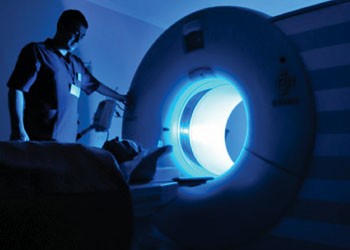Self-Assembling Nanoparticles Could Optimize MRI Scanning for Diagnosis of Cancer
By MedImaging International staff writers
Posted on 06 Aug 2014
To help clinicians diagnose cancer earlier, scientists have designed a new self-assembling nanoparticle that targets tumors.Posted on 06 Aug 2014
The new nanoparticle, developed by researchers from Imperial College London (UK), enhances the effectiveness of magnetic resonance imaging (MRI) scanning by specifically seeking out receptors that are found in cancerous cells.

Image: A nanoparticle developed by researchers at Imperial College London could boost the effectiveness of MRI scanning by zeroing in on receptors found in cancerous cells (Photo courtesy of Imperial College London).
The nanoparticle is coated with a specialized protein, which searches for specific signals given off by tumors, and when it finds a tumor, it begins to interact with the cancerous cells. This interaction shreds off the protein coating, causing the nanoparticle to self-assemble into a much larger particle so that it is more visible on the scan.
The new study published July 2014 in the journal Angewandte Chemie, used cancer cells and mouse models to compare the effects of the self-assembling nanoparticle in MRI scanning against commonly used imaging agents and found that the nanoparticle produced a more powerful signal and created a clearer MRI image of the tumor. The scientists noted that the nanoparticle increases the sensitivity of MRI scanning and will ultimately enhance the physician’s ability to detect cancerous cells at much earlier stages of development.
Prof. Nicholas Long, from the department of chemistry at Imperial College London, reported that the findings show real potential for improving cancer diagnosis. “By improving the sensitivity of an MRI examination, our aim is to help doctors spot something that might be cancerous much more quickly. This would enable patients to receive effective treatment sooner, which would hopefully improve survival rates from cancer. MRI scanners are found in nearly every hospital up and down the country and they are vital machines used every day to scan patients’ bodies and get to the bottom of what might be wrong. But we are aware that some doctors feel that even though MRI scanners are effective at spotting large tumors, they are perhaps not as good at detecting smaller tumors in the early stages.”
The newly designed nanoparticle provides a tool to improve the sensitivity of MRI scanning, and the scientists are now working to enhance its effectiveness. Prof. Long said, “We would like to improve the design to make it even easier for doctors to spot a tumor and for surgeons to then operate on it. We’re now trying to add an extra optical signal so that the nanoparticle would light up with a luminescent probe once it had found its target, so combined with the better MRI signal it will make it even easier to identify tumors.”
Before evaluating and injecting the nontoxic nanoparticle into mice, the scientists had to make certain that it would not become so large when it self-assembled that it would cause damage. They injected the nanoparticle into a saline solution inside a lab petri dish and tracked its growth over a four-hour period. The nanoparticle grew from 100-800 nm—still small enough to not cause any harm.
The scientists are now improving the nanoparticle and hope to assess their design in a human trial within the next three to five years.
Dr. Juan Gallo, from the department of surgery and cancer at Imperial College London, said, “We’re now looking at fine tuning the size of the final nanoparticle so that it is even smaller but still gives an enhanced MRI image. If it is too small the body will just secrete it out before imaging, but too big and it could be harmful to the body. Getting it just right is really important before moving to a human trial.”
Related Links:
Imperial College London













.jpg)
